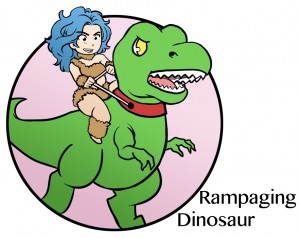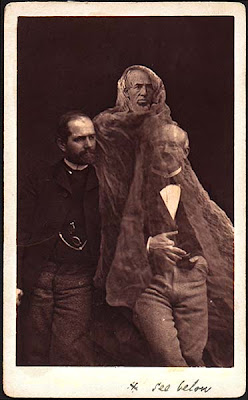Well it turns out the equivalent of a tutorial was included in Sir David Brewster’s 1856 book The Stereoscope, Its History, Theory, and Construction In his book Brewster explained how ghosts could be made to appear in photographs “for the purposes of amusement.”
 |
| So amusing… |
One of the easiest ways drew upon the slow exposure time of early cameras. Basically you had a person, or group of persons, pose normally for most of the period needed to expose the photographic plate. Then, just before the picture was finished you had someone- usually dressed in a spooky fashion- quickly walk in front of the camera and freeze in a pose for several seconds and then quickly walk out of the shot again.
Due to the long exposure, all of the things that were there before she walked on will be visible clearly through her, as if she was a transparent image in the midst of the group.
Several spirit photographs I’ve come across seem to use this trick.
 |
| I think her expression really gives away the fake here. |
But what do you do if the person sitting for the photograph isn’t in on the gig? What if they, like so many of those who sat for spirit photographs, think that it’s real?
Another book published in 1932 reveals even more tricks. This one was called Spook Crooks! Exploring the Secrets of the Prophet-eers Who Conduct Our Wickedest Industry and was written by Julien J. Proskauer.
Given the name, you can clearly see that Julien wasn’t a fan of the photography mediums. Proskauer was a magician who believed that these mediums were defrauding the public and published their tricks in order to make sure that no one fell for them.
He provided some great illustrations on how to make a spirit appear on camera. His suggestions included palming luminous pictures and objects and holding them against the photographic plate when the client wasn’t looking, or even exposing the plate before the client even got to the shop. Several spirit photographers actually insisted on getting plates before the sitting, claiming that they needed to keep the plates near their body to use their special magnetism to attract spirits to them.
Another possibility was to paint a picture on the background behind the sitter in quinine bisulphate or another fluorescent substance. This picture would be invisible to the naked eye but would photograph black. You could even cover the entire background with the substance, leaving certain specialized sections blank, causing them to seem white or light in the picture in comparison.
 |
| Perhaps that’s how this one was done |
Of course, these were only the more sophisticated tricks. Given that someone had to sit very still for a photograph one could always employ dummies or heads mounted on cardboard that could be deployed stealthily behind them.
What is interesting, though, is that these tricks were known at the time. There were skeptics out there pointing out how easy it would be to fake these pictures, but those who went to a sitting to get pictures of their dead loved ones closed their ears and eyes to that information and oftentimes refused to believe any later allegations of fraud.
One particular example was the trial of Edouard Isidore Buguet, a French medium, in 1875. Buget confessed after his studio was raided and two shrouded dummies and over 299 photographs of heads mounted on cardboard were discovered. But even though he confessed countless witnesses came to testify on his behalf.
Even after they faced him in the courtroom and he admitted that he had defrauded them they protested that the court was wrong. They believed that the photographs they had, and the spirits that were contained within, were real- no matter what anyone else said.
 |
| That is clearly not a dummy! Lalalala can’t hear you! |
On Friday check back for the last part of this series to find out about spirit photography today: how the medium has changed and how it’s still more popular than ever.




